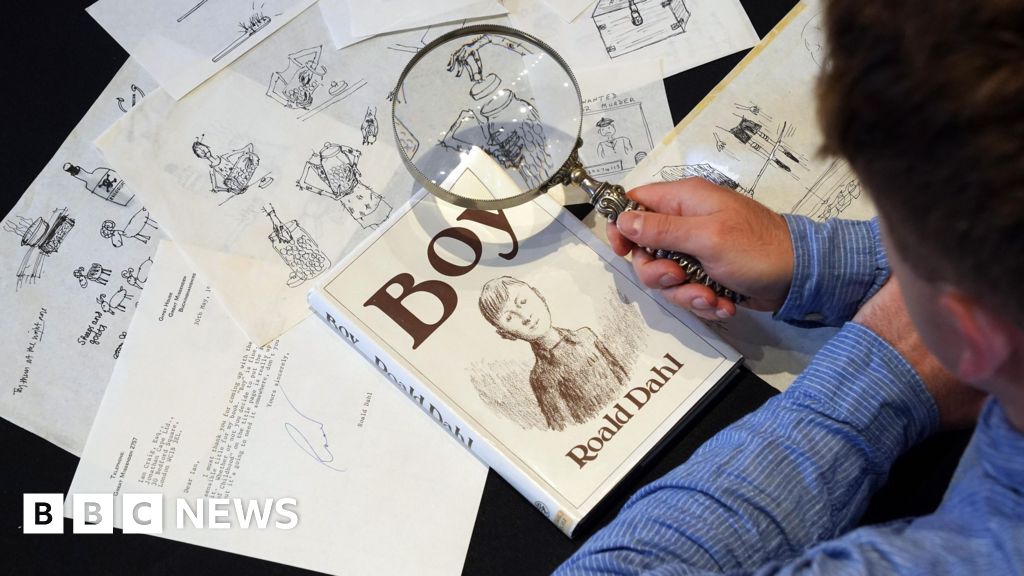ARTICLE AD BOX

The notebooks reveal Sir Ken Dodd worried his marathon shows were "ruining my life"
By Ian Youngs
Entertainment & arts reporter
Before he died, comedy legend Sir Ken Dodd left his wife instructions to burn hundreds of private notebooks that he filled with jokes and thoughts about his life and six-decade career.
However, she has revealed that after he passed away in 2018, she decided they were too important to destroy.
Lady Anne Dodd saved the books and is now putting a number of them on public display for the first time.
They are "unique" and "invaluable", she told BBC News.
Ten notebooks feature in an exhibition alongside memorabilia like Sir Ken's famous Diddymen puppets and tickling sticks at the Museum of Liverpool, in his home city.
Image source, Mark McNulty
Image caption,Lady Anne Dodd did not read the contents until after her husband died
The 10 have been chosen from about 1,000 surviving books in which the comedian recorded jokes - marking the best with the acronym GOG for "good old gag".
He also made observations about the art of comedy, while some pages give insights into intimate and revealing thoughts.
'Ruining my life'
The comedian noted his doubts about his famously lengthy performances, which would often stretch for several hours.
"I am ruining my life by doing such long shows," he wrote. "I am spoiling the quality of my lifestyle by being so self-indulgent and egotistical. I must take some material out."
The books also disclose how he critiqued his shows, making long lists of his routines and rating how each one went down with the audience - from poor to very good.
After shows, the comedian made a note of how his routines went down - poor, fair, good or v good
"A lot it was self-critical," Lady Anne said of the contents of the notebooks. "And some very deep thoughts. And once in a while, he'd say how happy he was doing what he did."
The comedian also drew "mind maps" about topics including showbusiness, which featured spider-like offshoots representing subjects ranging from jokes, theatres and TV shows to superstitions, stage fright and nerves.
Ken Dodd became one of Britain's biggest stars in the 1960s
Sir Ken insisted that the books should be destroyed after his death, Lady Anne told BBC entertainment correspondent Colin Paterson.
"He told me several times in the latter years of his life - he did say, 'You will burn everything when I'm gone? You will burn all my notebooks, won't you?'
"And I promised. I'm afraid I promised faithfully because he said it so adamantly.
"But when it came to think of it, I never thought of burning them. I knew I couldn't."
Image source, Gareth Jones
Image caption,Curator Karen O'Rourke with one of Sir Ken's famous tickling sticks
She had not read the books before her husband died at the age of 90, and said she wondered why he was determined that they should be destroyed.
"But there's nothing terrible or salacious or nasty about anybody or anything like that. I thought, am I going to find some really weird things in here? Not at all.
"Anything I have found is just part of him being an entertainer, and his thoughts and philosophising about things."
When considering what to do with the books, people on the comedy scene and in museums tried to convince her they should not go up in flames.
She eventually decided to preserve them, "not because I thought they were [financially] valuable, but I thought they were valuable because they're unique", she said. "And he was unique."
There are now "plans afoot" to give them a permanent home after the Liverpool exhibition, she said.
Museum of Liverpool curator Karen O'Rourke said: "He was such a public person but the thing about the notebooks is they've never been seen before.
"They were never meant to be seen, they were always only for Ken. So for us to have 10 on display is a real bonus for the exhibition."
Happiness! runs at the Museum of Liverpool from 9 September to 3 March 2024.

 1 year ago
28
1 year ago
28








 English (US) ·
English (US) ·